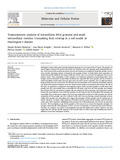Zitierlink:
https://doi.org/10.1016/j.mcp.2025.102026| DC Element | Wert | Sprache |
|---|---|---|
| crisitem.author.orcid | 0000-0001-9385-5670 | - |
| crisitem.author.orcid | 0000-0003-0892-4614 | - |
| dc.contributor.author | Nabariya, Deepti Kailash | - |
| dc.contributor.author | Knüpfer, Lisa Maria | - |
| dc.contributor.author | Hartwich, Patrick | - |
| dc.contributor.author | Killian, Manuela | - |
| dc.contributor.author | Centler, Florian | - |
| dc.contributor.author | Krauß, Sybille | - |
| dc.date.accessioned | 2025-03-27T09:32:05Z | - |
| dc.date.available | 2025-03-27T09:32:05Z | - |
| dc.date.issued | 2025 | de |
| dc.description | Finanziert aus dem DFG-geförderten Open-Access-Publikationsfonds der Universität Siegen für Zeitschriftenartikel | de |
| dc.description.abstract | Huntington's disease (HD) arises from the abnormal expansion of a CAG repeat in the HTT gene. The mutant CAG repeat triggers aberrant RNA-protein interactions and translates into toxic aggregate-prone polyglutamine protein. These aberrant RNA-protein ineractions also seed the formation of cytoplasmic liquid-like granules, such as stress granules. Emerging evidence demonstrates that granules formed via liquid-liquid phase separation can mature into gel-like inclusions that persist within the cell and may act as precursor to aggregates that occur in patients' tissue. Thus, deregulation of RNA granules is an important component of neurodegeneration. Interestingly, both the formation of intracellular membrane-less organelles like stress granules and the secretion of small extracellular vesicles (sEVs) increase upon stress and under disease conditions. sEVs are lipid membrane-bound particles that are secreted from all cell types and may participate in the spreading of misfolded proteins and aberrant RNA-protein complexes across the central nervous system in neurodegenerative diseases like HD. In this study, we performed a comparative transcriptomic analysis of sEVs and RNA granules in an HD model. RNA granules and sEVs were isolated from an inducible HD cell model. Both sEVs and RNA granules were isolated from induced (HD) and non-induced (control) cells and analyzed by RNA sequencing. Our comparative analysis between the transcriptomics data of HD RNA granules and sEVs showed that: (I) intracellular RNA granules and extracellular RNA vesicles share content, (II) several non-coding RNAs translocate to RNA granules, and (III) the composition of RNA granules and sEVs is affected in HD cells. Our data showing common transcripts in intracellular RNA granules and extracellular sEVs suggest that formation of RNA granules and sEV loading may be related. Moreover, we found a high abundance of lncRNAs in both control and HD samples, with several transcripts under REST regulation, highlighting their potential role in HD pathogenesis and selective incorporation into sEVs. The transcriptome cargo of RNA granules or sEVs may serve as a source for diagnostic strategies. For example, disease-specific RNA-signatures of sEVs can serve as biomarker of central nervous system diseases. Therefore, we compared our dataset to transcriptomic data from HD patient sEVs in blood. However, our data suggest that the cell-type specific signature of sEV-secreted RNAs as well as their high variability may make it difficult to detect these biomarkers in blood. | en |
| dc.identifier.doi | https://doi.org/10.1016/j.mcp.2025.102026 | de |
| dc.identifier.uri | https://dspace.ub.uni-siegen.de/handle/ubsi/2916 | - |
| dc.identifier.urn | urn:nbn:de:hbz:467-29162 | - |
| dc.language.iso | en | de |
| dc.rights | Namensnennung 4.0 International | * |
| dc.rights.uri | http://creativecommons.org/licenses/by/4.0/ | * |
| dc.source | Molecular and Cellular Probes ; Volume 81, 102026. - https://doi.org/10.1016/j.mcp.2025.102026 | de |
| dc.subject.ddc | 570 Biowissenschaften; Biologie | de |
| dc.subject.other | Extracellular vesicles | en |
| dc.subject.other | Huntington's disease | en |
| dc.subject.other | Neurodegeneration | en |
| dc.subject.other | RNA binding proteins | en |
| dc.subject.other | RNA granules | en |
| dc.subject.other | Stress granules | en |
| dc.subject.other | Extrazelluläre Bläschen | de |
| dc.subject.other | RNA-bindende Proteine | de |
| dc.title | Transcriptomic analysis of intracellular RNA granules and small extracellular vesicles: Unmasking their overlap in a cell model of Huntington's disease | en |
| dc.type | Article | de |
| item.fulltext | With Fulltext | - |
| ubsi.publication.affiliation | Institut für Biologie | de |
| ubsi.source.issn | 1096-1194 | - |
| ubsi.source.issued | 2025 | de |
| ubsi.source.issuenumber | 81 | de |
| ubsi.source.pages | 15 | de |
| ubsi.source.title | Molecular and cellular probes | de |
| Enthalten in den Sammlungen: | Geförderte Open-Access-Publikationen | |
Dateien zu dieser Ressource:
| Datei | Beschreibung | Größe | Format | |
|---|---|---|---|---|
| Transcriptomic_analysis_of_intracellular_RNA_granules.pdf | 9.65 MB | Adobe PDF |  Öffnen/Anzeigen |
Diese Ressource ist urheberrechtlich geschützt. |
Seitenansichten
29
checked on 02.04.2025
Download(s)
4
checked on 02.04.2025
Google ScholarTM
Prüfe
Prüfe
Diese Ressource wurde unter folgender Copyright-Bestimmung veröffentlicht: Lizenz von Creative Commons


